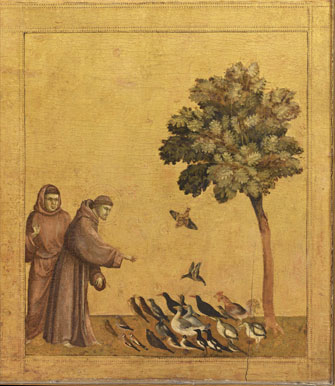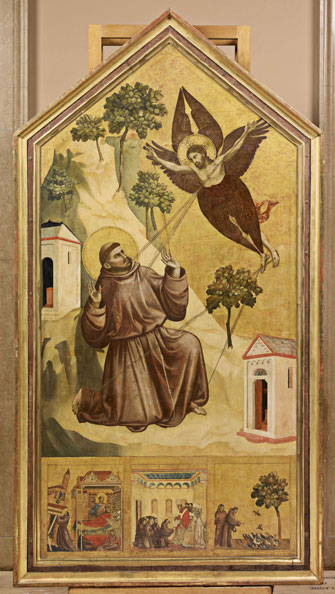On the Road to
The Renaissance

Saint Francis preaching to the birds, from the predella of “The Stigmatization of Saint Francis of Assisi” (c. 1295-1300). © RMN-Grand Palais (Musée du Louvre)/Michel Urtado
The Louvre has gathered together its holdings of works by Giotto (1266/67-1337) and his assistants and followers, and has borrowed others from various museums to create a fine little exhibition paying homage to the painter who is generally credited with lighting the way for the transition from the hieratic Byzantine and Gothic styles of medieval painting to the more naturalistic and individualized depictions of the Renaissance.
The exhibition follows Giotto di Bondone, to give him his full name, through his peregrinations around Italy, from his hometown of Florence to Assisi, Rome, Rimini, Padua, Milan and Naples, demonstrating quite effectively how his influence spread and persisted around the Italian peninsula.
The show opens with one of only three existing paintings signed by the artist: “The Stigmatization of Saint Francis of Assisi” (c. 1295-1300), a large, impressive panel showing the saint, down on one knee, lifting his hands in the air to receive the stigmata from a hovering Christ, who is decked in an insect-like winged costume, with a fantasy landscape in

”The Stigmatization of Saint Francis of Assisi“ (c. 1295-1300). © RMN-Grand Palais (Musée du Louvre)/Michel Urtado
the background. Innovations for the time – the expressiveness of the main figure, its sculptural roundness and the way the drapery shows the body underneath – are evident in this work with a glowing golden backdrop.
Another early work, the lovely “Madonna di San Giorgio alla Costa” (c. 1295), is a symphony in symmetry – with matching angels inclining their heads toward each other at the top of the painting and beautifully balanced bursts of reds and pinks against a patterned background in the center and a gold one above. The balance is broken only by the asymmetry of the Madonna with the Infant on her knee. The sweet-faced mother and authoritative child look as if they are posing for a formal snapshot. The curators note that, in contrast to the abstractions of Byzantine painting, in this work, “thanks to the rational lighting from a single source, the figures have real weight, a natural, physical presence, like the robust child, intensely human with his pink cheeks… For the first time, the depth of the Virgin’s throne and the room in the center of the Louvre’s predella [on “The Stigmatization”] is convincingly suggested.”
As Giotto’s fame spread and he was increasingly sought after for major commissions in various cities, more and more of the execution was done by his compagni (assistants). Inevitably, because so few works by the master himself are available, able to travel or definitively attributed to him, the show turns to their work (the most prominent of them is Taddeo Gaddi) and those of his followers. Many of these are impressive in themselves: take a close look at “The Crucifixion” (c. 1345) by a Neapolitan disciple of Giotto. The detail in the crowd at the foot of the cross is a marvel of diverse humanity. Individuals turn toward each other to converse, while children run around here and there. The tiny head of a baby peeps out over the shoulder of its mother, who is dressed in blue with a delicate gold scarf falling down her back. In the foreground, soldiers, also more interested in talking to each other than in the tragic scene before them, mill about on horseback.
If you can’t travel to Italy to see Giotto’s two most complete surviving works – the Scrovegni Chapel in Padua and the Lower Church in Assisi – this show is the next best thing.
Musée du Louvre: Hall Napoléon. Métro: Palais-Royal-Musée du Louvre. Open Wednesday-Monday, 9am-5.45pm (until 9.45pm on Wednesday and Friday). Closed Tuesday. Admission: €11. Through July 15, 2013. www.louvre.fr
Reader reaction: Click here to respond to this article (your response may be published on this page and is subject to editing).
Please support Paris Update by ordering books from Paris Update’s Amazon store at no extra cost. Click on your preferred Amazon location: U.K., France, U.S.
More reviews of Paris art shows.
© 2013 Paris Update
Favorite